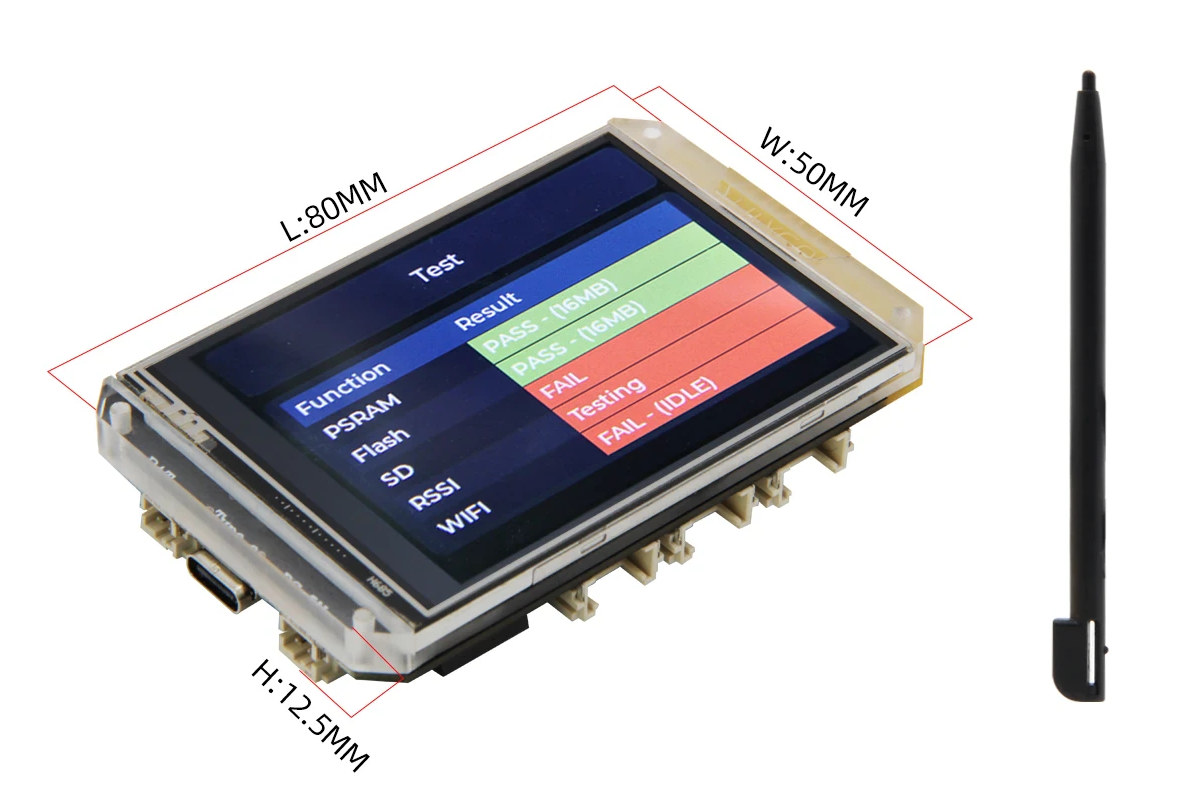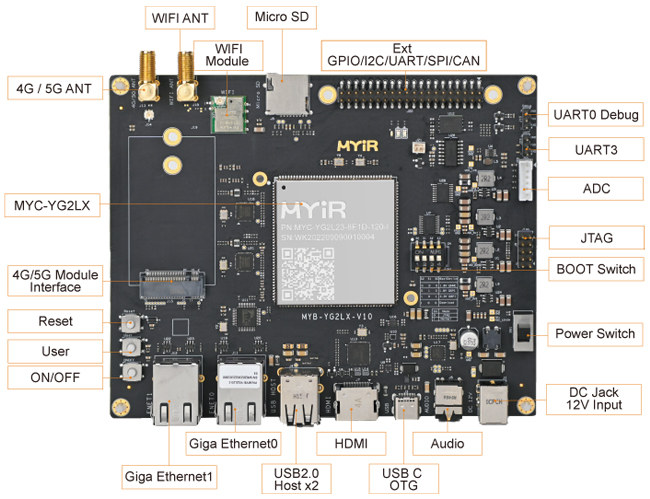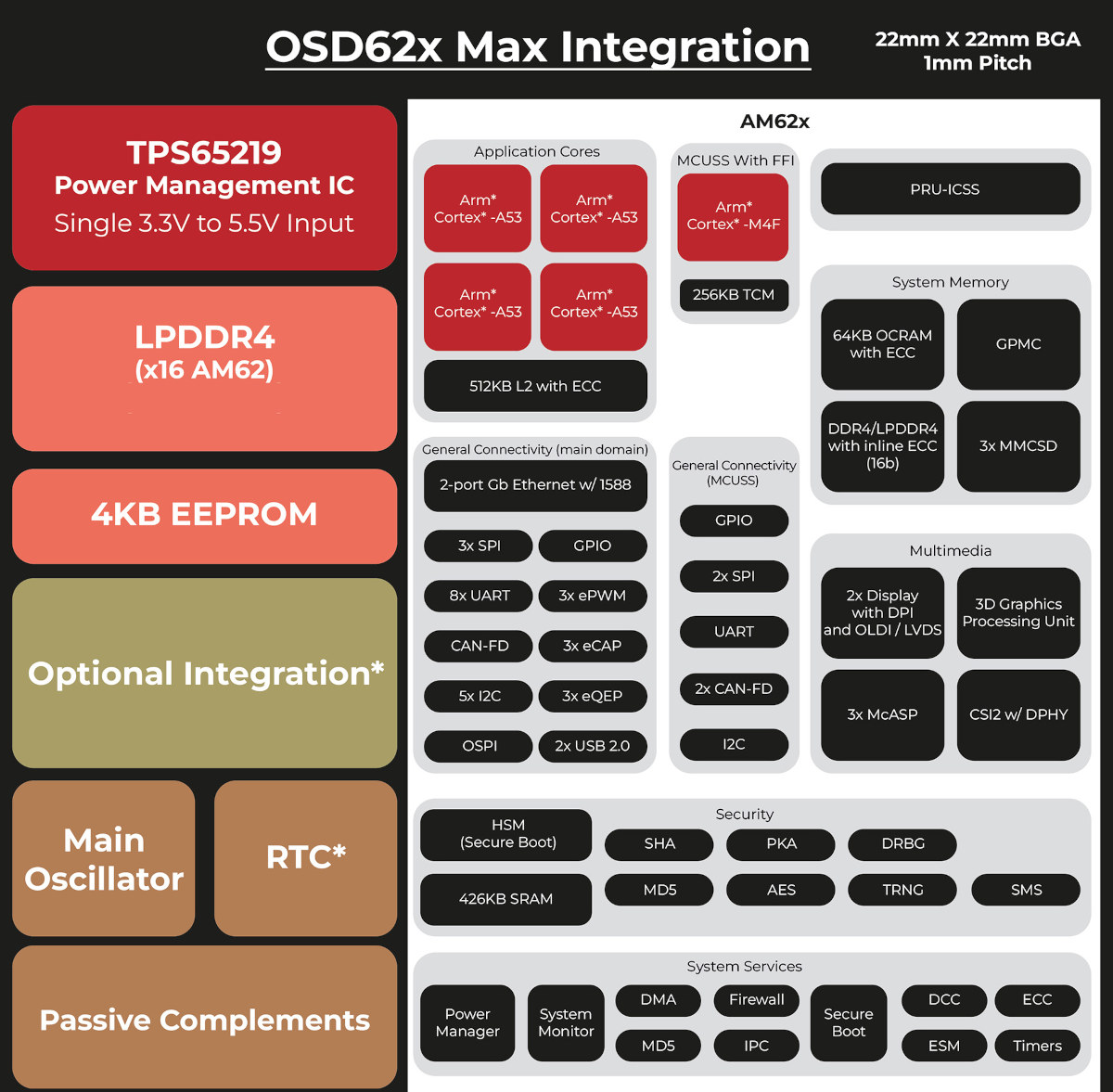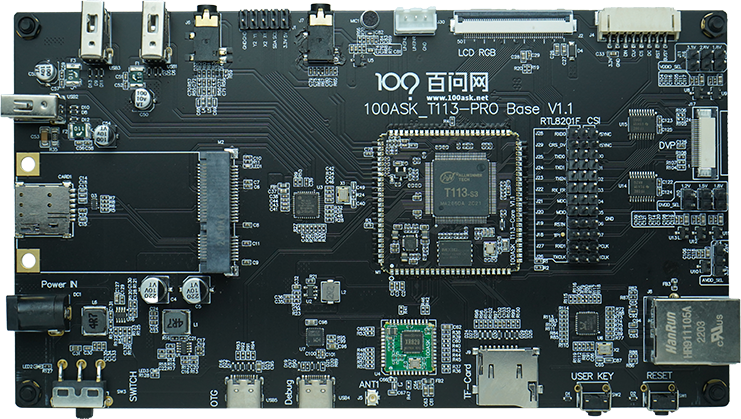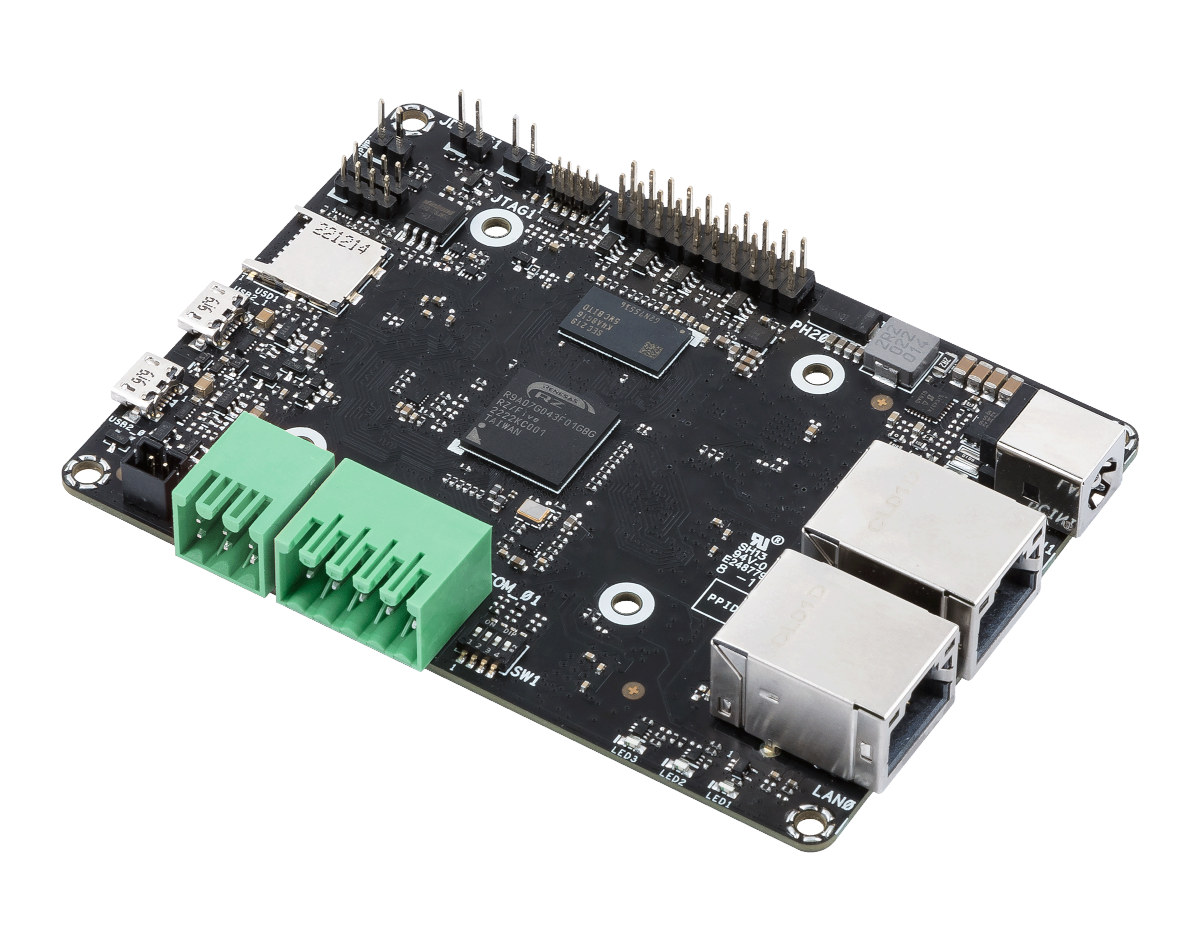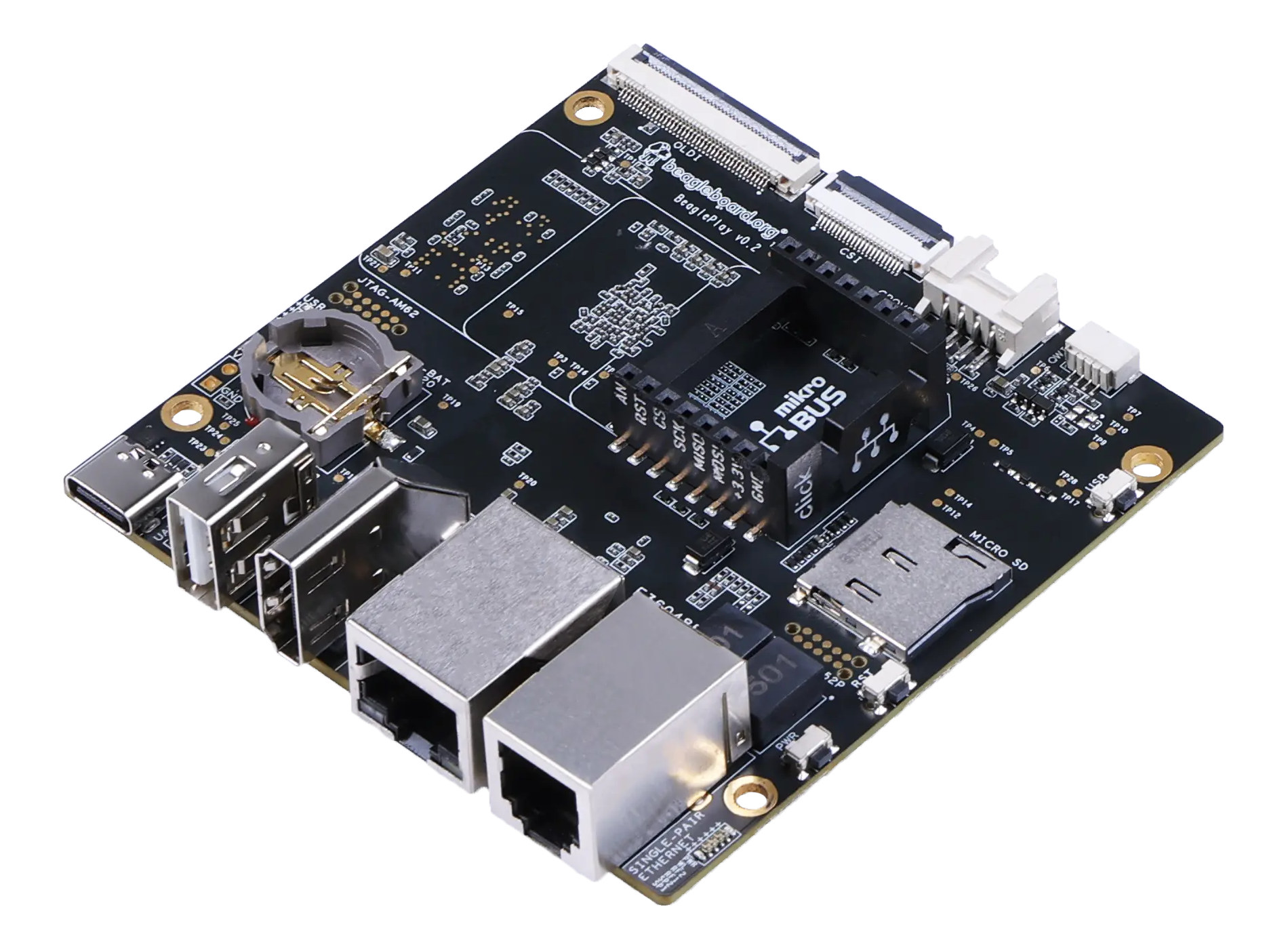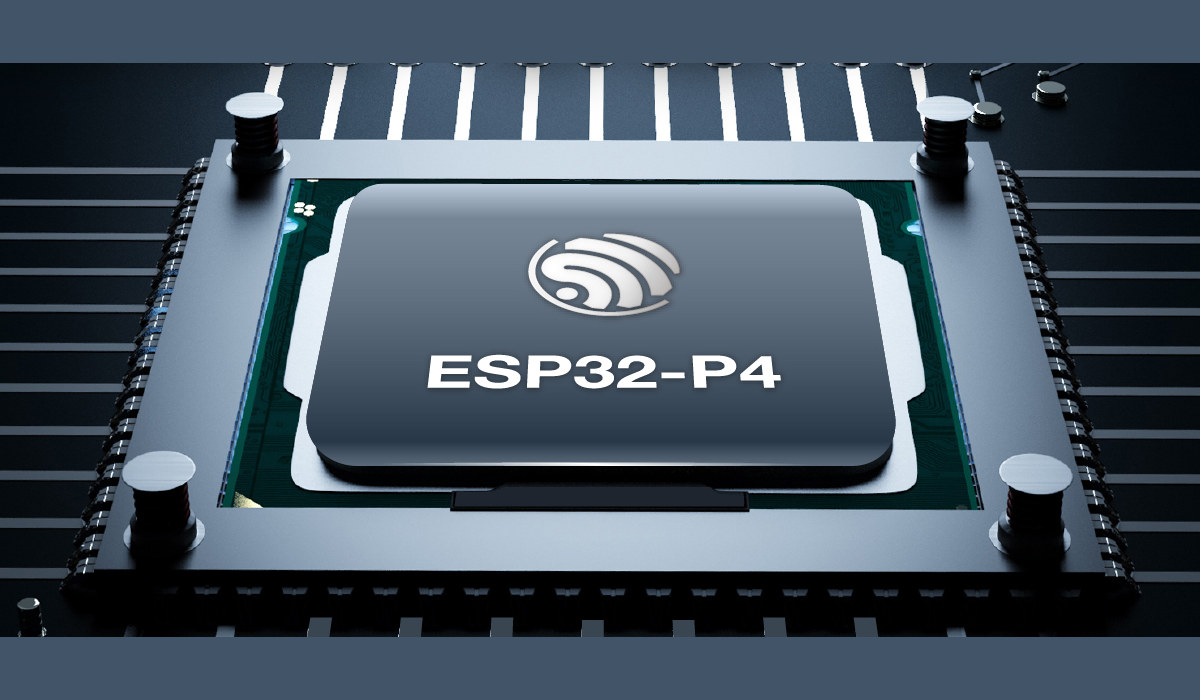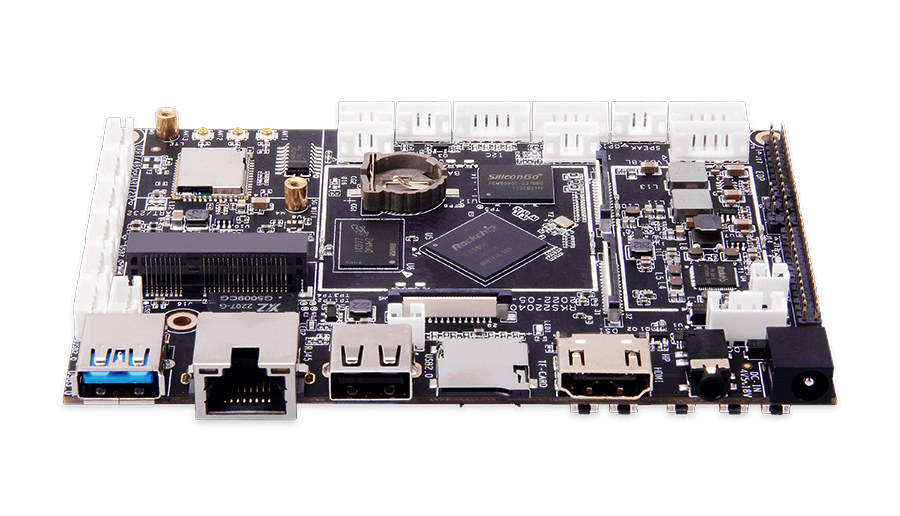Lilygo has launched yet another ESP32-S3 board with an integrated display, but the T-HMI has a larger 2.8-inch color display and a resistive touch panel suitable for HMI (Human Machine Interfaces). It is also equipped with three Grove connectors for expansion with sensors or actuators. Like all the recent ESP32-S3 boards from Lilygo, the T-HMI features the ESP32-S3R8 WiFi 4 and Bluetooth MCU with 8MB PSRAM, as well as a 16MB SPI flash, a microSD card slot, a few buttons, and power from USB or a LiPo battery. Lilygo T-HMI board specifications: Wireless MCU – Espressif Systems ESP32-S3R8 dual-core Tensilica LX7 @ up to 240 MHz with vector instructions for AI acceleration, 512KB RAM, 8MB PSRAM, wireless connectivity Storage – 16MB SPI flash, microSD card socket Connectivity via ESP32-S3 2.4 GHz 802.11 b/g/n Wi-Fi 4 with 40 MHz bandwidth support Bluetooth Low Energy (BLE) 5.0 connectivity with long-range support, up […]
Renesas RZ/G2L CPU module targets HMI and IoT gateway applications
MYIR MYC-YG2LX is Renesas RZ/G2L CPU module with up to 4GB DDR4, 32GB eMMC flash, and various I/Os such as gigabit Ethernet, USB 2.0, camera and display interfaces accessible through 222 castellated holes, and designed for advanced HMI, IoT edge gateways, and other embedded devices with video capabilities. As a reminder, the Renesas RZ/G2L microprocessor comes with up to two Arm Cortex-A55 cores clocked at 1.2 GHz, one 200 MHz Cortex-M33 real-time core, a Mali-G31 GPU for 3D graphics interfaces, and a VPU capable of H.264 encoding/decoding. The company also offers the MYD-YG2LX development board based on the 45x43mm MYC-YG2LX CPU module with easy access to its interfaces. MYIR MYC-YG2LX Renesas RZ/G2L CPU module MYC-YG2LX module specifications: SoC – Renesas RZ/G2L (R9A07G044L23GBG) dual-core Cortex-A55 processor with Cortex-M33 core @ 200 Mhz, Arm Mali-G31 GPU, H.264 hardware video decoding/encoding System Memory – 1 or 2GB DDR4 (option for up to 4GB) […]
OSD62x SiP combines TI AM62x processor with LPDDR4, EEPROM, PMIC, and passives into a single package
Octavo Systems OSD62x is a system-in-package (SiP) combining the Texas Instruments AM62x processor with LPDDR4 RAM, EEPROM, power management, oscillators, and passive components, plus optional features such as an RTC and an 8-channel ADC. At least that’s true for the OSD62x Max Integration SiP (22×22 mm BGA), but Octavo Systems also have a smaller 14x9mm package called the OSD62x Size Optimized with “just’ the AM62x processor, LPDDR4 memory, and passive components. OSD62x “Max Integration” specifications: SoC – Texas Instruments AM62x (AM623/AM625) CPU – Up to 4x Arm Cortex-A53 @ 1.4GHz MCU – Arm Cortex-M4F GPU – 3D graphics up to 2048×1080 @ 60 fps (AM625 only) Storage I/F – 1x eMMC, 2x SDIO, 1x GPMC Display I/F – 24-bit RGB MIPI DPI and OLDI/LVDS Camera I/F – 1x MIPI CSI-2 with DPHY 1.2 Networking – 2x 10/100/1000M Gigabit Ethernet with TSN support USB – 2x USB 2.0 interfaces PRU-ICSS Other […]
100ASK-T113-Pro Allwinner T113-S3 industrial board, and Allwinner T113-S4 with 256MB DDR3
Last year, Jean-Luc introduced the T113-S3 processor and the small MangoPi-Dual board with T113-S3. This time, I will introduce a development board with relatively rich resources, the 100ASK-T113-PRO, which consists of a core board with T113-S3 and a carrier board with a large number of peripheral interfaces, and the upcoming Allwinner T113-S4 SoC with 256MB DDR3. 100ASK-T113-Pro Allwinner T113-S3 industrial board While the T113-S3 and D1s/F133 RISC-V processors are pin-to-pin compatible, the T113-S3 is a dual-core Arm Cortex-A7 processor with HiFi4 DSP, CAN interfaces added (CAN is not mentioned publicly, but can be seen in the T113-S3 Datasheet) and 128MB DDR3 on-chip memory. 100ASK-T113-PRO preliminary specifications: T113-S3 Core Lite: SoC – Allwinner T113-S3 CPU – Dual-core Arm Cortex-A7 with 32 KB L1 I-cache + 32 KB L1 D-cache per core, and 256 KB L2 cache DSP – Single-core HiFi4 Memory – 128 MB DDR3 (SIP) Storage – 16MB SPI NandFlash […]
ASUS unveils Tinker V RISC-V single board computer, Tinker board 3 SBC with Rockchip RK3568 SoC
ASUS IoT has added two new members to the Tinker board family with the Tinker V and Tinker Board 3 single board computers powered by respectively Renesas RZ/Five single-core RISC-V SoC and Rockchip RK3568 quad-core Arm Cortex-A55 processor. ASUS Tinker V RISC-V SBC Tinker V specifications: SoC – Renesas RZ/Five single core AndesCore AX45MP RISC-V processor clocked at 1.0 GHz System Memory – 1GB DDR4 Storage – MicroSD card slot, optional 16GB eMMC flash, optional SPI flash Networking – 2x Gigabit Ethernet RJ45 ports USB – 1x Micro USB port, 1x Micro USB (OTG) port Serial – 2x CAN Bus via 6-pin terminal block 2x COM RS232 via 5-pin terminal block Expansion – 20-pin GPIO header with up to 2x UART, 2x I2C, 4x GPIO, 2x ADC, 1x SPI, 3.3V, and GND Debugging – JTAG pin header Power Supply – 10 to 24V DC via 5.5/2.5 mm DC barrel jack […]
BeaglePlay – A $99 Texas Instruments AM625 industrial SBC with plenty of communication and expansion options
The BeagleBoard.org Foundation has just launched their latest single board computer with the BeaglePlay SBC powered by a Texas Instruments AM625 Cortex-A53/M4/R5 processor with 16GB eMMC flash, 2GB DDR2, and a wide range of I/Os, wired and wireless communication options, and support for expansion module compatible with MikroBus, Grove, and Qwiic connectors. Two wired Ethernet are offered, namely a typical Gigabit Ethernet RJ45 port, as well as a single-pair Ethernet RJ11 port limited to 10 Mbps but with a much longer range and power over data, and wireless connectivity includes dual-band WiFi 4, Bluetooth LE, and Sub-GHz. The board also features HDMI and MIPI DSI display interfaces and a MIPI CSI camera interface. BeaglePlay specifications: SoC – Texas Instruments Sitara AM625 (AM6254) with Quad-core 64-bit Arm Cortex-A53 processor @ 1.4 GHz Arm Cortex-M4F at up to 400 MHz Arm Cortex-R5F PowerVR Rogue 3D GPU supporting up to 2048×1080 @ 60fps, […]
Espressif ESP32-P4 – A 400 MHz general-purpose dual-core RISC-V microcontroller
Espressif ESP32-P4 is a general-purpose dual-core RISC-V microcontroller clocked at up to 400 MHz with AI instructions extension, numerous I/Os, and security features. It also happens to be the first microcontroller from Espressif Systems without wireless connectivity, and as such, it should probably be seen as an alternative to STM32F7/H7 or NXP i.RT Arm Cortex-M7 microcontrollers/crossover processors, and likely offered at a significantly lower cost. It should also offer lower power consumption than other ESP32 chips thanks in part to a third RISC-V core clocked at 40 MHz that can keep the system running while the other two high-performance cores are down. ESP32-P4 key features and specifications: MCU subsystems Dual-core RISC-V HP (High-performance) CPU @ up to 400 MHz with AI instructions extension and single-precision FPU, 768KB of on-chip SRAM Single-RISC-V LP (Low-power) MCU core @ up to 40 MHz with 8KB of zero-wait TCM RAM Memory & Storage I/F […]
Geniatech DS-3566 digital signage board is powered by a Rockchip RK3566 SoC
Geniatech DS-3566 is a board based on Rockchip RK3566 designed for digital signage applications with a low-profile, multiple video interfaces such as HDMI, LVDS, eDP, and MIPI DSI, and plenty of headers and connectors for expansion. The single board computer ships with up to 8GB RAM, 128GB eMMC flash, and supports Gigabit Ethernet, WiFi 5, Bluetooth 4.1, as well as cellular connectivity as an option. Some of the interfaces available through connectors include RS232, RS485, CAN Bus, I2C, SPI, etc… Geniatech DS-3566 specifications: SoC – Rockchip RK3566 quad-core Arm Cortex-A55 processor @ 1.8 GHz with Arm Mali-G52 EE GPU, 0.8 TOPS NPU System Memory – 2GB to 8GB LPDDR4 Storage – 16GB to 128GB eMMC flash, MicroSD card slot Video Interfaces 1x HDMI 2.1 up to 4Kp60 1x LVDS header and backlight header 1x eDP header and backlight header 1x 4-lane MIPI DSI connector Camera – 1x 4-lane MIPI CSI […]


